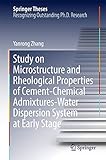Study on Microstructure and Rheological Properties of Cement-Chemical Admixtures-Water Dispersion System at Early Stage [electronic resource] / by Yanrong Zhang.
By: Zhang, Yanrong [author.] .
.
Contributor(s): SpringerLink (Online service) .
.
Material type:  BookSeries: Springer Theses, Recognizing Outstanding Ph.D. Research: Publisher: Singapore : Springer Nature Singapore : Imprint: Springer, 2018Edition: 1st ed. 2018.Description: XVIII, 258 p. 143 illus., 110 illus. in color. online resource.Content type: text Media type: computer Carrier type: online resourceISBN: 9789811045707.Subject(s): Mechanics, Applied
BookSeries: Springer Theses, Recognizing Outstanding Ph.D. Research: Publisher: Singapore : Springer Nature Singapore : Imprint: Springer, 2018Edition: 1st ed. 2018.Description: XVIII, 258 p. 143 illus., 110 illus. in color. online resource.Content type: text Media type: computer Carrier type: online resourceISBN: 9789811045707.Subject(s): Mechanics, AppliedIntroduction -- Methodology.- Rheological properties of fresh cement pastes -- Mesostructure of fresh cement pastes -- Mechanism of chemical admixtures: Adsorption, Hydration and Rheology.- Microstructure model and rheological model of fresh cement pastes.- Pore structure and impermeability of hardened cement pastes.- Conclusions of the research.
This thesis studies the effects of superplasticizers, polyacrylate latexes and asphalt emulsions, which differ in molecular/particle size from nanometers to microns, on the rheological properties of fresh cement pastes (FCPs), as well as the action mechanisms involved. It systematically investigates the rheological properties and microstructure of cement-based materials, and elucidates the adsorption behaviors of polycarboxylate polymers with different functional groups and their effects on cement hydration. Moreover, it reveals how the working mechanism of naphthalene sulfonate formaldehyde (NSF) differs from that of polycarboxylate ether-based (PCE) superplasticizers. Lastly, it develops a conceptual microstructure model and two rheological equations. These findings lend theoretical support to the development of new chemical admixtures and new, higher-performance, cement-based composites.


There are no comments for this item.